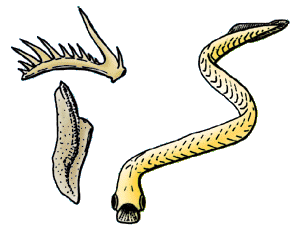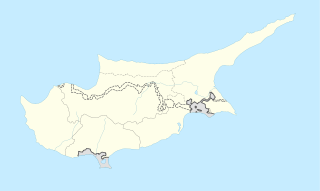Related Research Articles

Conodonts are extinct agnathan chordates resembling eels, classified in the class Conodonta. For many years, they were known only from tooth-like microfossils found in isolation and now called conodont elements. Knowledge about soft tissues remains limited. The animals are also called Conodontophora to avoid ambiguity.

The Early Jurassic epoch is the earliest of three epochs of the Jurassic period. The Early Jurassic starts immediately after the Triassic-Jurassic extinction event, 201.3 Ma, and ends at the start of the Middle Jurassic 174.1 Ma.
The Rhaetian is, in geochronology, the latest age of the Triassic period or in chronostratigraphy the uppermost stage of the Triassic system. It lasted from 208.5 to 201.3 million years ago. It was preceded by the Norian and succeeded by the Hettangian.
In the geologic timescale, the Anisian is the lower stage or earliest age of the Middle Triassic series or epoch and lasted from 247.2 million years ago until 242 million years ago. The Anisian age succeeds the Olenekian age and precedes the Ladinian age.
The Carnian is the lowermost stage of the Upper Triassic series. It lasted from 237 to 227 million years ago (Ma). The Carnian is preceded by the Ladinian and is followed by the Norian. Its boundaries are not characterized by major extinctions or biotic turnovers, but a climatic event occurred during the Carnian and seems to be associated with important extinctions or biotic radiations.
In the geologic timescale, the Wuchiapingian or Wujiapingian is an age or stage of the Permian. It is also the lower or earlier of two subdivisions of the Lopingian epoch or series. The Wuchiapingian spans the time between 259.1 and 254.14 million years ago (Ma). It was preceded by the Capitanian and followed by the Changhsingian.
In the geologic time scale, the Changhsingian or Changxingian is the latest age or uppermost stage of the Permian. It is also the upper or latest of two subdivisions of the Lopingian epoch or series. The Changhsingian lasted from 254.14 to 251.902 million years ago (Ma). It was preceded by the Wuchiapingian and followed by the Induan.
In the geologic timescale, the Olenekian is an age in the Early Triassic epoch or a stage in the Lower Triassic series. It spans the time between 251.2 Ma and 247.2 Ma. The Olenekian follows the Induan and is followed by the Anisian.
The Induan is, in the geologic timescale, the first age of the Early Triassic epoch or the lowest stage of the Lower Triassic series. It spans the time between 251.902 Ma and 251.2 Ma. It is preceded by the Changhsingian and is followed by the Olenekian.
The Ladinian is a stage and age in the Middle Triassic series or epoch. It spans the time between 242 Ma and ~237 Ma. The Ladinian was preceded by the Anisian and succeeded by the Carnian.
Hindeodus is an extinct genus of conodonts in the family Anchignathodontidae. The generic name Hindeodus is a tribute to George Jennings Hinde.
The Norian is a division of the Triassic geological period. It has the rank of an age (geochronology) or stage (chronostratigraphy). The Norian lasted from ~227 to 208.5 million years ago. It was preceded by the Carnian and succeeded by the Rhaetian.
Neogondolellla is an extinct genus of conodonts. Neogondolela regalis was re-evaluated in 2018 by Martyn Lee Golding.
Chiosella is an extinct conodont genus.
Metapolygnathus is an extinct genus of platform conodonts.
Epigondolella is an extinct genus of conodonts in the family Gondolellidae.
Conodonts are an extinct class of animals whose feeding apparatuses called teeth or elements are common microfossils found in strata dating from the Stage 10 of the Furongian, the fourth and final series of the Cambrian, to the Rhaetian stage of the Late Triassic. These elements can be used alternatively to or in correlation with other types of fossils in the subfield of the stratigraphy named biostratigraphy.
Misikella is an extinct genus of conodonts. It is a genus with a tetramembrate conodont apparatus.
References
- ↑ Triassic conodonts from western North America and Europe and their correlation. LC Mosher, Journal of Paleontology, July 1968, Vol. 42, No. 4, pages 895-946 (Stable URL)
- Two new genera Comperniodontella n. gen. and Galeodontella n. gen., and new multielement of Chirodella Hirschmann, 1959 and Cypridodella Mosher, 1968 (Conodonta) from the Mamonia Complex (Upper Triassic), Cyprus. Christopher C. Ryley and Lars E. Fahraeus, Neues Jahrbuch fuer Geologie und Palaeontologie Abhandlungen, 1994, volume 1931, pages 21–54
Chirodella is an extinct genus of conodonts in the family Prioniodinidae.

Mamonia is a village in the Paphos District of Cyprus, located 8 km northeast of Nikokleia.
